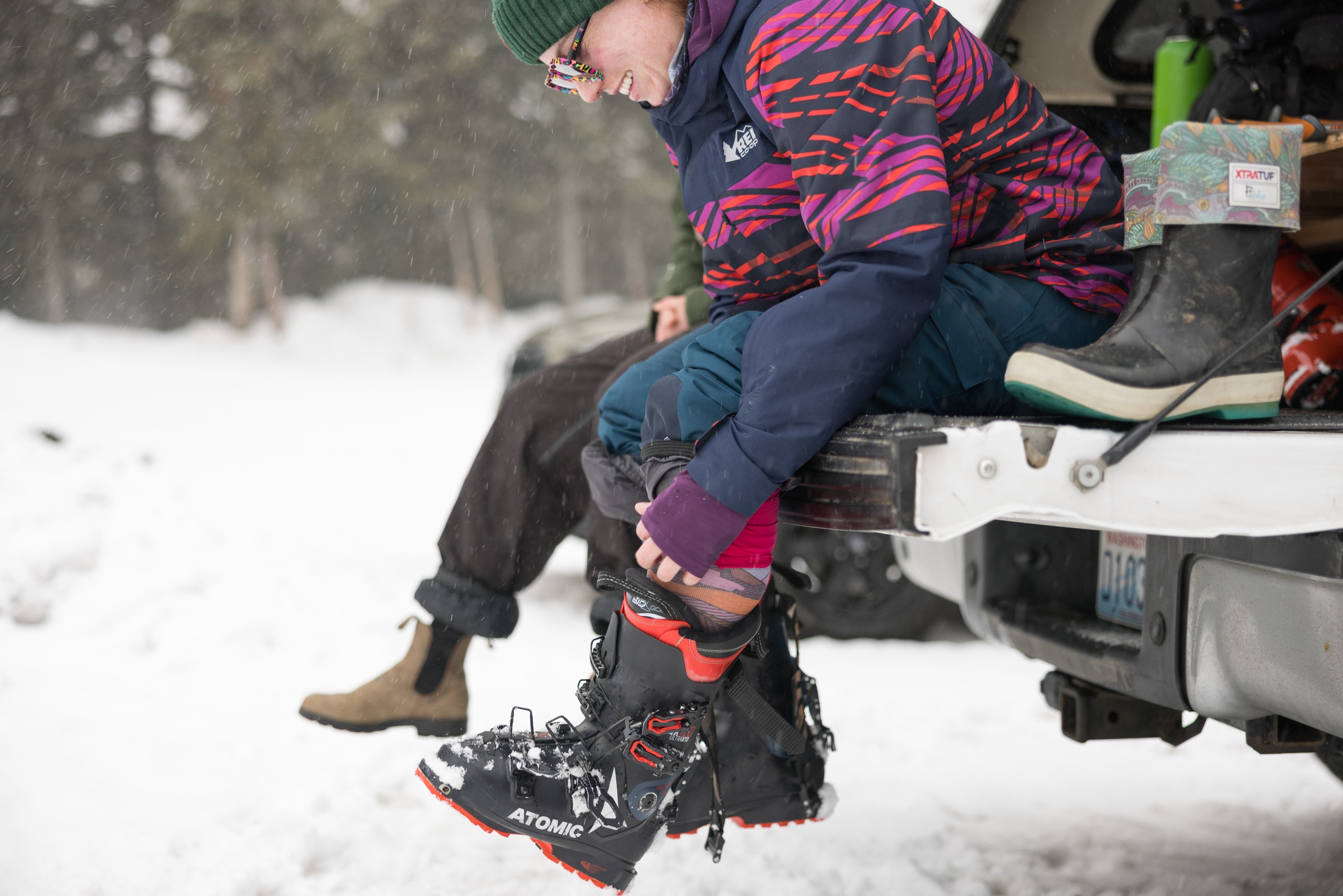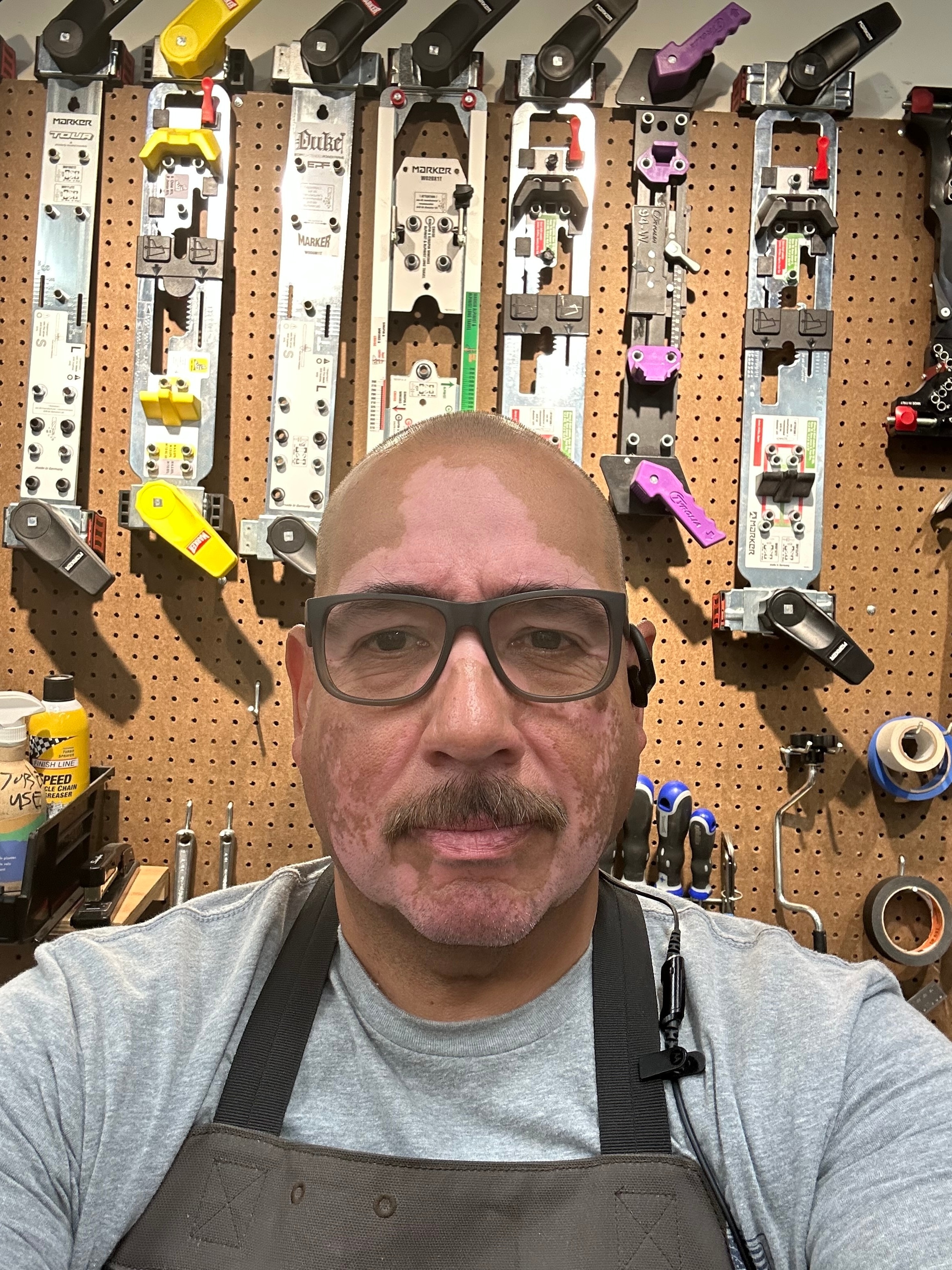Ski boots are one of the most critical components of your ski setup, so getting the right size and fit is essential to ensure they perform and feel the way they’re supposed to. A properly fitting ski boot means you ski better, plain and simple.
Everything starts with making sure you’re in the right size. Surprisingly, many skiers wear boots that don’t fit properly. An in-store boot fitting expert can help by measuring your foot and ensuring you’re in the right size. After that, you can fine-tune the fit by customizing the shell or liner, or making other adjustments based on your foot shape and stance.
Use the links below to jump to a specific section or continue reading for a complete guide to sizing ski boots.
- How to measure and size ski boots
- How ski boots should feel
- Signs your ski boots are the right size
- Pro tips for trying on ski boots
- Customizing your ski boot
Editor's Note: We updated this article on Oct. 13, 2025, to add more information and charts on finding the right fit, understanding volume and last width, and customizing your boots.
How to Measure and Size Ski Boots
A good ski boot fit starts with finding the right size for your foot. Downhill skiing boots use an international sizing system called Mondopoint, which is based on your foot length in centimeters. (For example, a Mondo 23 equals 23 centimeters). The best approach is to have your foot measured at a store like REI that sells ski boots, though you can also do this at home.
Generally, shoe size can translate to Mondopoint size, but it’s still best to measure your foot for a more precise fit.
Chart: Mondo Ski Boot Sizes to US Sizes
Mondo | 21.5 | 22 | 22.5 | 23 | 23.5 | 24 | 24.5 | 25 | 25.5 | 26 |
|---|---|---|---|---|---|---|---|---|---|---|
Women's U.S. | 5 | 5.5 | 6 | 6.5 | 7 | 7.5 | 8 | 8.5 | 9 | 9.5 |
Men's U.S. | NA | NA | NA | 5 | 5.5 | 6 | 6.5 | 7 | 7.5 | 8 |
Mondo | 26.5 | 27 | 27.5 | 28 | 28.5 | 29 | 29.5 | 30 | 30.5 |
|---|---|---|---|---|---|---|---|---|---|
Women's U.S. | 10 | 10.5 | 11 | 11.5 | 12 | NA | NA | NA | NA |
Men's U.S. | 8.5 | 9 | 9.5 | 10 | 10.5 | 11 | 11.5 | 12 | 13 |
Tips for Measuring Your Foot at Home
- Place two sheets of blank paper against a wall and have a marker ready.
- While wearing a thin pair of ski socks, stand with your heels touching the wall and your weight evenly distributed on each piece of paper.
- Carefully draw a line at your heel and at the end of your big toe.
- Then measure the length of each foot, in centimeters, using the longer measurement (since feet are rarely the exact same size) as your Mondopoint size.
Understanding Ski Boot Width (last)
The width of the inside of the ski boot at the ball of the foot is called last. Last widths typically range from about 97mm to 106mm and are predetermined for each boot size by the boot manufacturer. A narrower last is sometimes called a low-volume boot, while boots with a wider last are considered high volume. Skiers with narrower feet or those looking for a high-performance fit may opt for a narrow last, while those with broader feet or who want a more spacious, comfortable feel may prefer a wider last.
How to Get a Good Shell Fit
You may want to pull the liner out of the boot and see how the shell fits first.
- While wearing ski socks, slide your foot into the empty shell and press your toes to the front of the boot.
- You should be able to slide two fingers behind your heel. If you can only fit one finger, you’ll want to size up. If you can fit three fingers or more, you’ll need to size down.
- Your foot also shouldn't be touching the sides of the shell when you stand.
Video: How to Size Ski Boots
In this short video we show you how to try on ski boots, including how to do a shell fit, how to buckle the boots and what to look for as you examine the fit.
How a Ski Boot Should Feel
Ski boots shouldn’t feel like sneakers. They should fit snugly and firmly, like a solid handshake. A tighter fit generally makes a boot more responsive and helps transfer energy to your skis. While ski boots shouldn’t be uncomfortable or cause pain, they should wrap around your foot with minimal wiggle room.
Keep in mind that you can adjust your boot with aftermarket customizations. If the boot isn't perfect out of the box, slight tweaks can make a big difference. In other words, start with a boot that fits, then customize it so it’s perfect.
How to Tell If Your Ski Boots are the Right Size
- While wearing thin socks, put on your boots and buckle them as if you were going skiing.
- Stand up and flex your knees and ankles so you’re in an athletic stance. Drive your shins forward into the front of the boot.
- Pay attention to how things feel. Your toes should brush the front of the boot without curling under or feeling tight or jammed. Your heels should remain firmly in the heel pocket without lifting or movement.
Pro Tips for Trying on Ski Boots
Here are some things to keep in mind when trying on ski boots:
- Wear thin ski socks made from a synthetic or wool fabric. Avoid thick hiking socks and cotton.
- Trim your toenails before you try on ski boots. You want the front of the boot to hit your skin, not your nails.
- Try boots on later in the day if possible, as feet tent to swell and will be at their largest in the afternoon or evening.
- A boot will feel the tightest when you try it on in the store but will break in over time.
- Check your toe position: When standing upright, your toes should brush the end of the boots, but they shouldn't be crammed or curled under.
- While wearing the boots, drop into an athletic squat position. Your toes should just barely pull away from brushing the front of the boot. The fit should not be painful.
- Check your heels: When bending your knees, your heels should stay firmly in the heel pocket.
- Wear the boots for at least 20 minutes, if possible, to make sure they are comfortable.
- Ski boot materials can react to changing temperatures. So, keep in mind that in cold temperatures, boots can feel stiffer and tighter, whereas in warmer temperatures, they can feel softer or more expansive.
- Buckling tip: Ideally, buckling your boots to the second or third wrung should give you a firm but comfortable fit.
Customizing Ski Boots
The way a ski boot feels out of the box is just the beginning. You can make additional adjustments and customizations to fine-tune the fit so your boots suit your feet. Here are a few common ski boot customization options:
Add a New Footbed
- Many fit-related issues in ski boots can be solved with a new footbed. After-market insoles, or footbeds, are a popular way to improve the fit and add support. Your options include:
- For a little extra support, try a cut-to-fit insole.
- For a more customized fit, get a custom-molded cork insole. The insole is heated, vacuum-molded and massaged to fit your foot—a 25-minute process. Many REI stores make custom-molded insoles. Contact your local store to check.
- If you have foot issues, choose a physician-made orthotic.
Heat-mold Liners
Many ski boots come with liners that can be heat molded for a more custom fit. Some liners require in-store heat molding through a specialized process, done by a boot fitting expert. Others can be done at home. Some liners will naturally shape to your foot over time without any additional heat-molding or customization work. Check the details of your liner so you know what’s possible.
In this video, we show you how mold your liners at home.
Video: How to Custom Mold Ski Boot Liners
Cuff Canting
Many skiers are knock-kneed or bowlegged. In-store cuff canting, or cuff alignment, can help balance your stance and allow for more lateral side to side movement by adjusting the position of the upper cuff in relation to the lower foot area. This is usually done by adjusting a hinge on either side of the ankle of the ski boot where the upper and lower part of the boot meet.
To check your stance for cuff canting:
Stand with your feet aligned under your shoulders and look in a mirror. Slowly bring your feet toward one another slowly:
- If you’re bowlegged, your feet will touch first.
- If you’re knock-kneed, your ankles will touch first.
Cuff canting aligns the boot cuff to match bowed or knock-kneed skier stances. Any adjustments with the cuff should complement your natural stance, not alter it—so it’s best to work with a ski-boot specialist to make these adjustments.
Adjusting Forward Lean
A trained boot fitter can also advise if you need your forward lean adjusted. Forward lean is the angle of the boot’s cuff, which affects your skiing stance.
Most boots come with 13 to 15 degrees of forward lean. More upright boots, like those built for freestyle skiers, will have 13 degrees or less, while race boots for elite athletes may have up to 17 degrees of forward lean.
Aggressive skiers may want more forward lean, while those with limited range of motion in their ankles may want less forward lean.
Test your ankle flexion at home:
- Stand barefoot with your feet flat on the ground.
- Bend your knees as far forward as you can and notice when your heels lift off the ground.
- If your knees go past your toes, you have ample range of motion.
- If you can’t get your knees to your toes before your heels go up, you have limited range of motion.
Other fit modifications
A professional boot fitter may also recommend:
- Heat molding the shell for more toe space
- Adding a heel wedge to lift the heel
- Stretching or grinding the liners
Why Trust This Guide
To compile this resource on downhill ski boots, we interviewed ski experts at REI and beyond. Our experts have written about skiing for major publications, provided gear recommendations to outdoor enthusiasts and helped hundreds find the right boot fit.
Meet the experts
Megan Michelson, a Tahoe-based freelance journalist and longtime REI contributor, learned to ski when she was 2. A former editor at Skiing Magazine, she has been testing and writing about ski gear for going on two decades now.
Miguel Castro, a shop service manager at the REI store in Laguna Hills, California, has been a ski boot fitter for over a decade. With more than six years of boot fitting experience across three REI locations, he has helped over 1,200 skiers and snowboarders find their perfect boot fit. He’s also worked with wounded veterans who require specialized customization. Miguel has completed two years of training with MasterFit University, a leading program for snowsports boot fitters. Among the courses, he completed an advanced boot customization class focused on medical and special-case fittings.
Andrew White, an REI merchandising replenishment analyst for snowsports, has worked as a ski boot fitter at the Denver REI store for 16 years. He’s been an REI employee since 1999.
Matt Manser, ski boot product manager for Atomic, is a former boot fitter who knows the ins and outs of ski boots perhaps better than anyone. He’s based in Austria.


